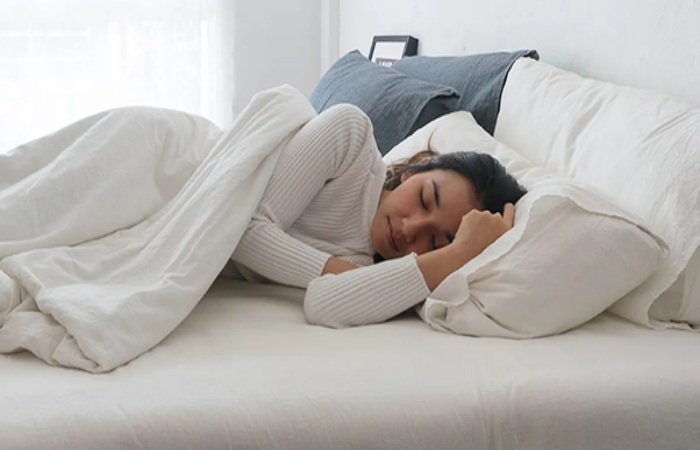Back Pain While Sleeping
The way the human spine curves, it must maintain its natural alignment to function properly. When we sleep, any position other than lying on one’s back can misalign the spine and lead to discomfort. This may include spines that are too curved forward or spines that are bent backward, either way, your body needs space for proper alignment while you sleep.
Causes Of Back Pain While Sleeping

Tight Muscles: There are several different reasons why you may be experiencing this pain. It can be caused by tight muscles. These are typically tight in the neck and around the spinal column. They are also typically found in muscles that have become stretched out. If you are sleeping with these muscles tense and tight, the ligaments holding them in place will be damaged or stretched.
Structure Of Spinal Column: Another reason you may experience pain is from the structure of the spinal column. It can be very difficult to regulate what exactly is causing your back pain. The pain may be felt in one area of your body but then transferred to another area. For example, your neck may hurt but then so does your back. This may indicate a problem that starts in one part of the body and then moves on to another.
Back pain while sleeping is something that affects many individuals. When the spinal column is put under undue stress, it is likely to result in pain. When the back is weak, it is much easier for joints to put pressure on other bones, creating a pain situation. This is why so many individuals have taken steps to ensure that they are sleeping in a position that does not put undue stress on their back. You should also understand that there is no single cure for the causes of back pain while sleeping. You must work to strengthen all of the muscles in your back to ensure that they remain as strong as possible.
Compression In Spinal: Problems in the muscles can often result in the spine becoming misaligned. For this to occur, the bones must be pushed out of alignment and the cartilage between the bones and the vertebrae must be compressed. This compression can cause pain in the spinal column and down to the legs. Compression of the spinal column often occurs in the lumbar region, but it may also be felt in the sacrum and even in the hips and legs. You may even feel the pain in your feet.
One Knee Bent: Not everyone finds that a sleeping position that pulls the curve of the spine causes their pain to disappear. Some people feel that their pain increases while they are sleeping. This can happen if the person is sleeping with one knee bent and another placed flat on the floor. There is no best month to buy a mattress, you can purchase a good mattress. While this can cause some slight discomfort, it will quickly go away when the person moves to a sleeping position that doesn’t put excess stress on the joints.
The Right Sleep Positions For Treatment

Sleeping in the right position is decisive to your night’s rest. Not all sleep positions are created equal. A common belief is that lying on your back makes for a good night’s sleep. While lying on your back may provide some relief of pain and tension, it is not the most comfortable position. It can lead to neck pain, back pain, shoulder pain, and even insomnia!
Side Sleeper: An excellent choice for a side sleeper is to lay on your side with your knees up against the edge of the bed. This will provide support for your lower back and will help keep the pressure off your neck. It will also help keep your hips in the proper position as you sleep. You must sleep on your side because if you sleep on your back it can cause a wide array of problems including improper breathing and circulation, as well as difficulty breathing and relaxing.
Stomach Sleeper: Another excellent sleeping position is to sleep on your stomach with your knees bent and your head nestled between your hands. By keeping your head nestled between your hands, you will be better able to relax and drift into a peaceful and relaxing sleep. When you slumber on your stomach it is much easier to fall asleep on your back or side. If you need to sleep on your stomach for an extended period (common after work), it may be best to keep your head elevated. This will help keep your posture correct and will prevent your head from rolling too far to the side.
Back Sleeper: If you are having trouble getting comfortable when you lie on your back, try sleeping on your side. Lying on your back provides the perfect position to have your head propped up so that it can breathe and stretch. If you sleep on your side, it is also easier to fall asleep because you will not be bending so far. Many people find that sleeping on their stomachs can be very uncomfortable. Most people recycle mattresses too . To make yourself more comfortable, it is best to purchase a quality foam mattress. A quality foam mattress allows your body to rest in the most natural position possible, which helps you to fall asleep faster and more comfortably.
Swimming: In addition to the use of pillows and mattresses, other sleep positions can be very effective for treatment. Swimming can be a very relaxing position and many individuals report great results when they take a short swim in a pool or near the water. Sleeping with another person in a sleeping position that is similar to a stroke recovery position, such as with your head propped up and legs raised can also be very effective. Reading books while lying prone is another option. The choice of which sleep position is best for you will depend on what your issues are and how they affect your sleeping patterns.
Conclusion
The right sleep positions for treatment are very important for those who need to rest during the night. When you do not get enough sleep, you become tired, irritable, and lose the ability to think clearly. If you are unsure which sleep position would best suit your needs, you should consult your doctor or sleep specialist.
